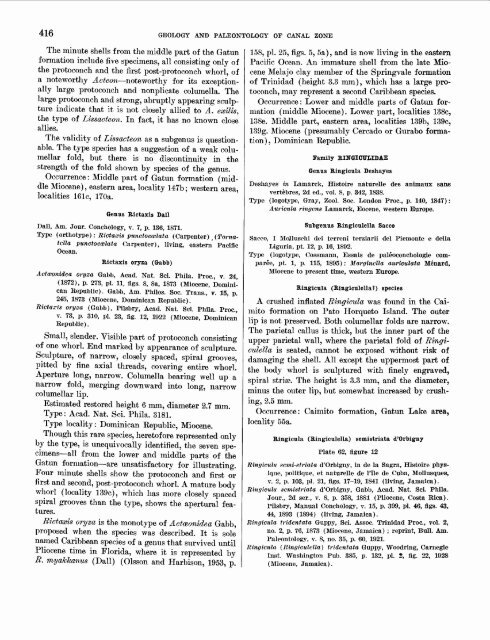Geology and Paleontology of Canal Zone and Adjoining ... - USGS
Geology and Paleontology of Canal Zone and Adjoining ... - USGS
Geology and Paleontology of Canal Zone and Adjoining ... - USGS
Create successful ePaper yourself
Turn your PDF publications into a flip-book with our unique Google optimized e-Paper software.
416 GEOLOGY AND PALEONTOLOGY OF CANAL ZONE<br />
The minute shells from the middle part <strong>of</strong> the Gatun<br />
formation include five specimens, all consisting only <strong>of</strong><br />
the protoconch <strong>and</strong> the first post-protoconch whorl, <strong>of</strong><br />
a noteworthy Acteon noteworthy for its exception<br />
ally large protoconch <strong>and</strong> nonplicate columella. The<br />
large protoconch <strong>and</strong> strong, abruptly appearing sculp<br />
ture indicate that it is not closely allied to A. exilis,<br />
the type <strong>of</strong> Lissacteon. In fact, it has no known close<br />
allies.<br />
The validity <strong>of</strong> Lissacteon as a subgenus is question<br />
able. The type species has a suggestion <strong>of</strong> a weak colu-<br />
mellar fold, but there is no discontinuity in the<br />
strength <strong>of</strong> the fold shown by species <strong>of</strong> the genus.<br />
Occurrence: Middle part <strong>of</strong> Gatun formation (mid<br />
dle Miocene), eastern area, locality 14/Tb; western area,<br />
localities 161c, I70a.<br />
Genus Rictaxis Ball<br />
Dall, Am. Jour. Conchology, v. 7, p. 136, 1871.<br />
Type (orthotype): Rictaxis punctoccelata (Carpenter), (Tornatella<br />
punctoccelata Carpenter), living, eastern Pacific<br />
Ocean.<br />
Rictaxis oryza (Gabb)<br />
Actceonidea oryza Gabb, Acad. Nat. Sci. Phila. Proc., v. 24,<br />
(1872), p. 273, pi. 11, figs. 8, 8a, 1873 (Miocene, Domini<br />
can Republic). Gabb, Am. Philos. Soc. Trans., v. 15, p.<br />
245, 1873 (Miocene, Dominican Republic).<br />
Rictaxis oryza (Gabb), Pilsbry, Acad. Nat. Sei. Phila. Proc.,<br />
v. 73, p. 310, pi. 23, fig. 12, 1922 (Miocene, Dominican<br />
Republic).<br />
Small, slender. Visible part <strong>of</strong> protoconch consisting<br />
<strong>of</strong> one whorl. End marked by appearance <strong>of</strong> sculpture.<br />
Sculpture, <strong>of</strong> narrow, closely spaced, spiral grooves,<br />
pitted by fine axial threads, covering entire whorl.<br />
Aperture long, narrow. Columella bearing well up a<br />
narrow fold, merging downward into long, narrow<br />
columellar lip.<br />
Estimated restored height 6 mm, diameter 2.7 mm.<br />
Type: Acad. Nat. Sci. Phila. 3181.<br />
Type locality: Dominican Republic, Miocene.<br />
Though this rare species, heret<strong>of</strong>ore represented only<br />
by the type, is unequivocally identified, the seven spe<br />
cimens all from the lower <strong>and</strong> middle parts <strong>of</strong> the<br />
Gatun formation are unsatisfactory for illustrating.<br />
Four minute shells show the protoconch <strong>and</strong> first or<br />
first <strong>and</strong> second, post-protoconch whorl. A mature body<br />
whorl (locality 139c), which has more closely spaced<br />
spiral grooves than the type, shows the apertural fea<br />
tures.<br />
Rictaxis oryza is the monotype <strong>of</strong> Actceonidea Gabb,<br />
proposed when the species was described. It is sole<br />
named Caribbean species <strong>of</strong> a genus that survived until<br />
Pliocene time in Florida, where it is represented by<br />
R. myakkanus (Dall) (Olsson <strong>and</strong> Harbison, 1953, p.<br />
158, pi. 25, figs. 5, 5a), <strong>and</strong> is now living in the eastern<br />
Pacific Ocean. An immature shell from the late Mio<br />
cene Melajo clay member <strong>of</strong> the Springvale formation<br />
<strong>of</strong> Trinidad (height 3.3 mm), which has a large pro<br />
toconch, may represent a second Caribbean species.<br />
Occurrence: Lower <strong>and</strong> middle parts <strong>of</strong> Gatun for<br />
mation (middle Miocene). Lower part, localities 138c,<br />
138e. Middle part, eastern area, localities 139b, 139c,<br />
139g. Miocene (presumably Cercado or Gurabo forma<br />
tion), Dominican Republic.<br />
Family RINGICTTLIDAE<br />
Genus Ringicula Deshayes<br />
Deshayes in Lamarck, Histoire naturelle des animaux sans<br />
vertebres, 2d eel., vol. 8, p. 342, 1838.<br />
Type (logotype, Gray, Zool. Soc. London Proc., p. 140, 1847):<br />
Auricula ringens Lamarck, Eocene, western Europe.<br />
Subgenus Ringiculella Sacco<br />
Sacco, I Molluschi del terreni terziarii del Piemonte e della<br />
Liguria, pt. 12, p. 16, 1892.<br />
Type (logotype, Cossmann, Essais de paleoconchologie com-<br />
paree, pt. 1, p. 115, 1895): Marginella auriculata Menard,<br />
Miocene to present time, western Europe.<br />
Ringicula (Ringiculella?) species<br />
A crushed inflated Ringicula was found in the Cai-<br />
mito formation on Pato Horqueto Isl<strong>and</strong>. The outer<br />
lip is not preserved. Both columellar folds are narrow.<br />
The parietal callus is thick, but the inner part <strong>of</strong> the<br />
upper parietal wall, where the parietal fold <strong>of</strong> Ringi<br />
culella is seated, cannot be exposed without risk <strong>of</strong><br />
damaging the shell. All except the uppermost part <strong>of</strong><br />
the body whorl is sculptured with finely engraved,<br />
spiral strise. The height is 3.3 mm, <strong>and</strong> the diameter,<br />
minus the outer lip, but somewhat increased by crush<br />
ing, 2.5 mm.<br />
Occurrence: Caimito formation, Gatun Lake area,<br />
locality 55a.<br />
Ringicula (Ringiculella) semistriata d'Orbigny<br />
Plate 62, figure 12<br />
Ringicula semi-striata d'Orbigny, in de la Sagra, Histoire phys<br />
ique, politique, et naturelle de Tile de Cuba, Mollusques,<br />
v. 2, p. 103, pi. 21, figs. 17-19, 1841 (living, Jamaica).<br />
Ringicula semistriata d'Orbigny, Gabb, Acad. Nat. ScL Phila.<br />
Jour., 2d ser., v. 8, p. 358, 1881 (Pliocene, Costa Rica).<br />
Pilsbry, Manual Conchology, v. 15, p. 399, pi. 46, figs. 43,<br />
44, 1893 (1894) (living, Jamaica).<br />
Ringicula tridentata Guppy, Sci. Assoc. Trinidad Proc., vol. 2,<br />
no. 2, p. 76, 1873 (Miocene, Jamaica) ; reprint, Bull. Am.<br />
<strong>Paleontology</strong>, v. 8, no. 35, p. 60, 1921.<br />
Ringicula (Ringiculella) tridentata Guppy, Woodring, Carnegie<br />
Inst. Washington Pub. 385, p. 132, pi. 2, fig. 22, 1928<br />
(Miocene, Jamaica).

















